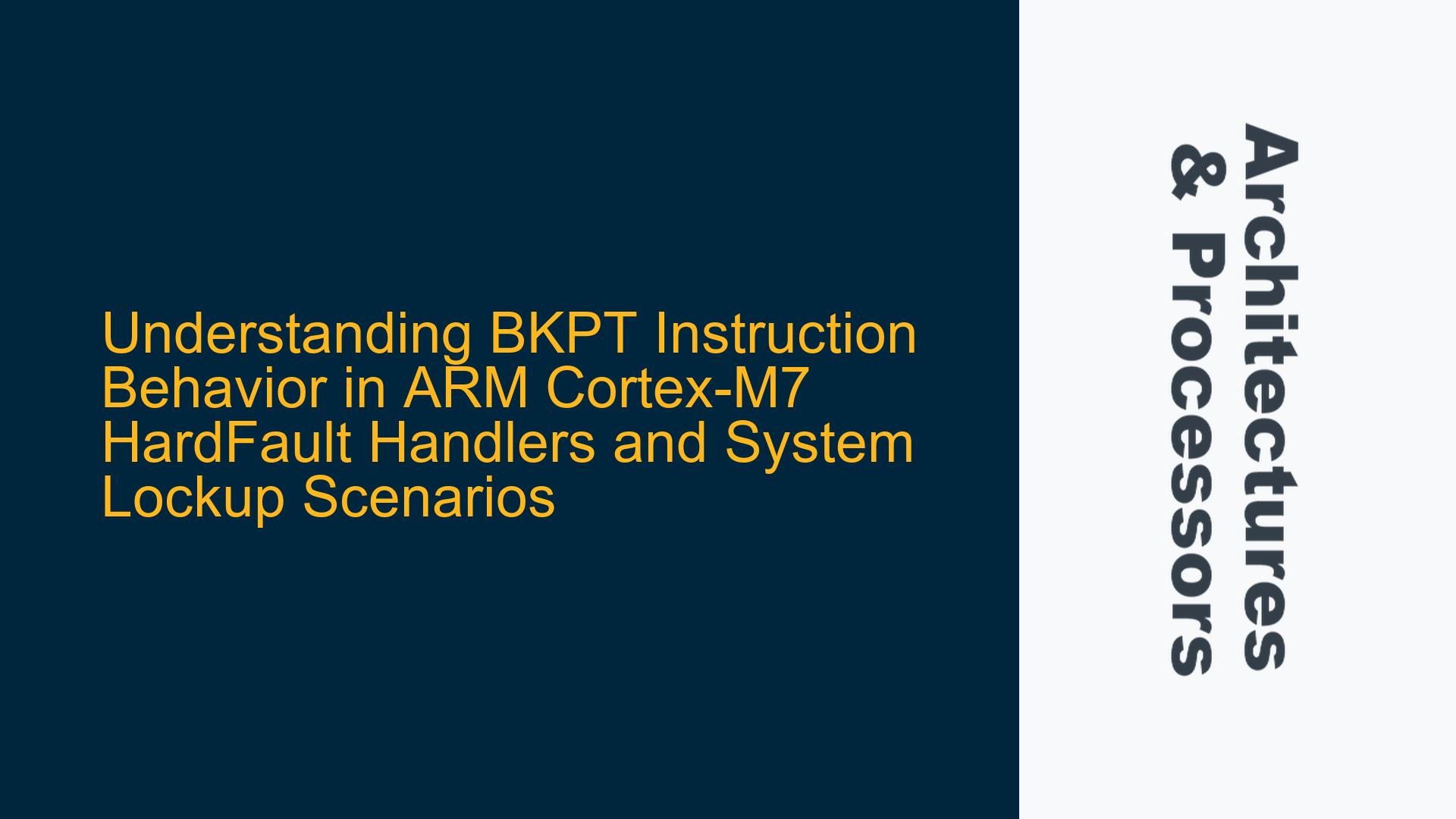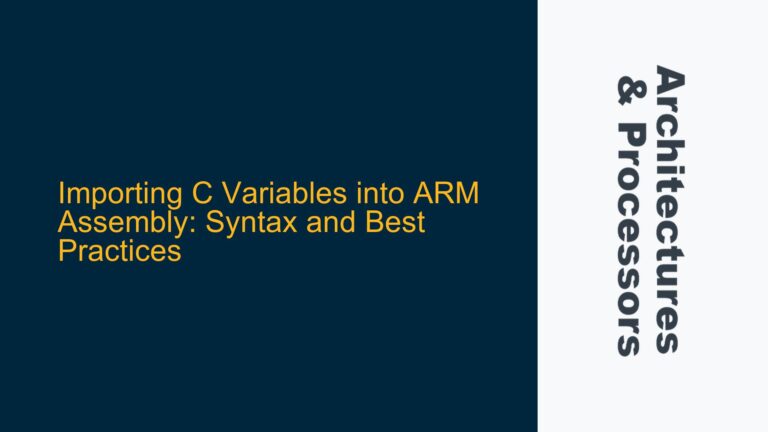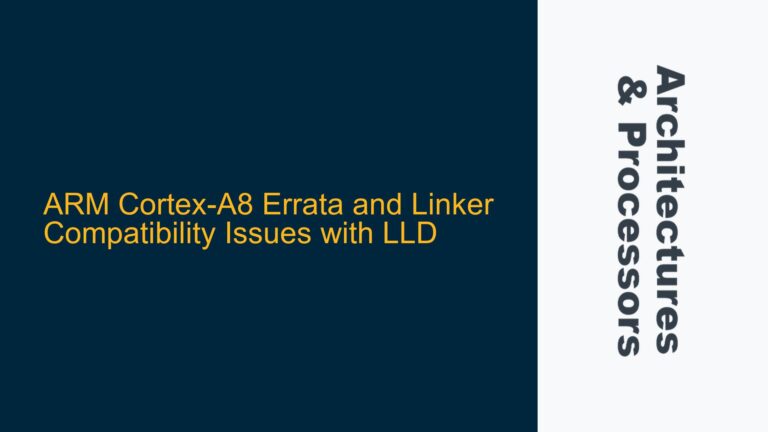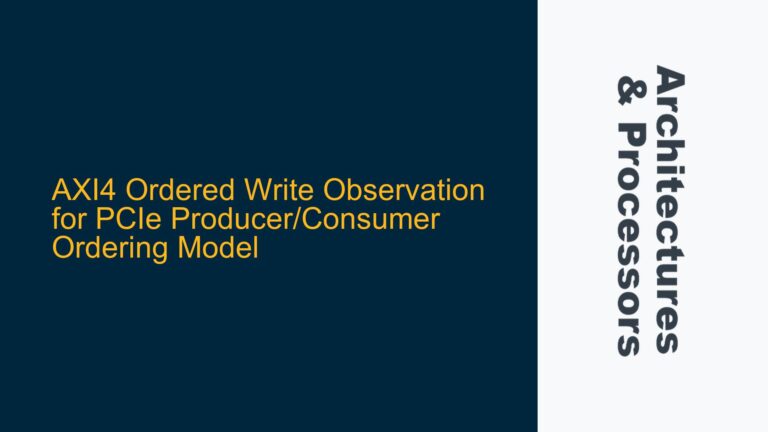ARM Cortex-M7 HardFault Handler Behavior with BKPT Instruction
The behavior of the ARM Cortex-M7 processor when encountering a BKPT instruction within a HardFault handler is a critical topic for embedded systems engineers. The BKPT instruction, short for "Breakpoint," is typically used for debugging purposes. However, its behavior changes significantly depending on whether a debugger is attached and whether the Debug Monitor exception is enabled. In the context of a HardFault handler, the BKPT instruction can lead to system lockup or escalation to a HardFault, depending on the configuration and the state of the processor.
When a HardFault occurs, the processor enters the HardFault handler, which is the highest priority exception handler in the ARM Cortex-M7 architecture. If the HardFault handler contains a BKPT instruction and no debugger is attached, the processor will escalate the breakpoint event to a HardFault. This escalation is described in the ARM®v7-M Architecture Reference Manual, specifically in section C1.5. The manual states that if both halting debug and the monitor are disabled, a breakpoint debug event escalates to a HardFault, and the processor ignores other debug events.
However, if the BKPT instruction is encountered within the HardFault handler itself, and no debugger is attached, the system will enter a lockup state. This is because the processor cannot escalate the breakpoint event further, as it is already in the highest priority exception handler. The lockup state is an unrecoverable error condition where the processor stops executing instructions and requires a system reset to recover. This behavior is also documented in the ARM®v7-M Architecture Reference Manual, which states that if a breakpoint occurs in an NMI or HardFault exception handler when halting debug is disabled, the system locks up with an unrecoverable error.
The lockup state is particularly problematic in systems where reliability is critical. For example, in the case of the NXP i.MX-RT106A processor, the system may sometimes lock up and other times reset when a BKPT instruction is encountered in the HardFault handler. This inconsistency can be attributed to the processor’s internal status signals, which may or may not trigger an automatic reset depending on the configuration and external monitoring.
Memory Barrier Omission and Cache Invalidation Timing
One of the key factors that can influence the behavior of the BKPT instruction in a HardFault handler is the timing of memory barriers and cache invalidation. The ARM Cortex-M7 processor features a highly optimized memory system with caches and write buffers that can affect the execution of instructions, including BKPT. When a HardFault occurs, the processor must ensure that all pending memory operations are completed before entering the HardFault handler. This is typically achieved using memory barriers, such as the Data Synchronization Barrier (DSB) and Instruction Synchronization Barrier (ISB).
If memory barriers are omitted or incorrectly placed, the processor may execute the BKPT instruction before completing all pending memory operations. This can lead to unpredictable behavior, including system lockup or incorrect escalation of the breakpoint event. Additionally, the timing of cache invalidation can affect the execution of the BKPT instruction. If the cache is not properly invalidated before entering the HardFault handler, the processor may execute stale instructions, leading to further complications.
In the context of the NXP i.MX-RT106A processor, the timing of memory barriers and cache invalidation can be influenced by the processor’s internal configuration and external memory interfaces. For example, if the processor is configured to use a high-speed external memory interface, the timing of memory operations may be affected, leading to delays in completing memory barriers and cache invalidation. This can result in inconsistent behavior when encountering a BKPT instruction in the HardFault handler, with the system sometimes locking up and other times resetting.
Implementing Data Synchronization Barriers and Cache Management
To address the issues related to the BKPT instruction in the HardFault handler, it is essential to implement proper data synchronization barriers and cache management techniques. The following steps outline the recommended approach for ensuring reliable behavior when encountering a BKPT instruction in the HardFault handler:
-
Ensure Proper Memory Barrier Usage: Before entering the HardFault handler, ensure that all pending memory operations are completed using the appropriate memory barriers. The Data Synchronization Barrier (DSB) should be used to ensure that all data memory operations are completed before proceeding. The Instruction Synchronization Barrier (ISB) should be used to ensure that the processor fetches the correct instructions after the memory barrier.
-
Invalidate Cache Before Entering HardFault Handler: Before entering the HardFault handler, invalidate the cache to ensure that the processor does not execute stale instructions. This can be achieved using the cache maintenance operations provided by the ARM Cortex-M7 processor. The cache invalidation should be performed after the memory barriers to ensure that all pending memory operations are completed before invalidating the cache.
-
Implement System Reset in HardFault Handler: To avoid system lockup when encountering a
BKPTinstruction in the HardFault handler, implement a system reset within the handler. This ensures that the system can recover from an unrecoverable error condition without requiring external intervention. The system reset can be triggered using the processor’s internal reset mechanism or an external watchdog timer. -
Monitor Processor Status Signals: The ARM Cortex-M7 processor exports a number of status signals, including one for lockup. Monitor these signals to detect when the processor enters a lockup state and trigger an automatic reset if necessary. This can be achieved using external hardware or software monitoring mechanisms.
-
Enable Debug Monitor Exception: If debugging is required, consider enabling the Debug Monitor exception. This allows the processor to handle breakpoint events without escalating them to a HardFault. However, this approach should be used with caution, as it can introduce additional complexity and potential security risks.
By following these steps, embedded systems engineers can ensure reliable behavior when encountering a BKPT instruction in the HardFault handler. Proper memory barrier usage, cache management, and system reset implementation are critical for avoiding system lockup and ensuring that the system can recover from unrecoverable error conditions. Additionally, monitoring processor status signals and enabling the Debug Monitor exception can provide additional flexibility and debugging capabilities when needed.
In conclusion, the behavior of the BKPT instruction in the HardFault handler is a complex topic that requires careful consideration of memory barriers, cache management, and system reset mechanisms. By understanding the underlying principles and implementing the recommended techniques, engineers can ensure reliable and predictable behavior in their ARM Cortex-M7 based systems.





